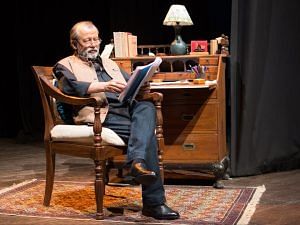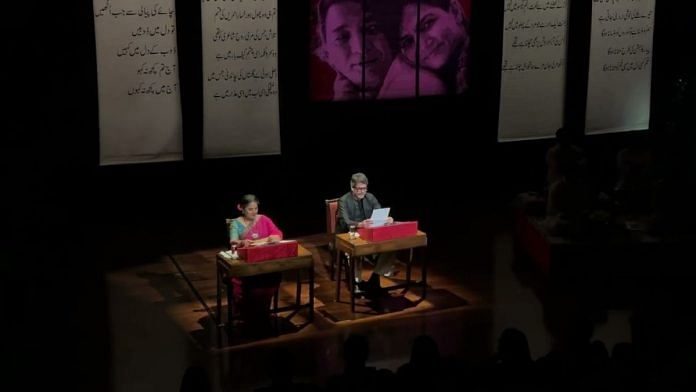New Delhi: Naseeruddin Shah, Shabana Azmi, Piyush Mishra, and Pankaj Kapur — it took the return of big Bollywood stars to the stage to breathe life back into Delhi’s flailing theatre-going culture last weekend.
The Delhi theatre scene in the past decade has been bedevilled with an unprecedented crisis of content, cash, and cultural patronage. As viewing cultures move online, even pandemic fatigue could not force people back to the physical entertainment space.
“Theatre, an art form that embodies all other creative pursuits like music, dance, painting, etc., is meant to evoke dialogue, which, in the last few years, has subsided,” says theatre veteran MK Raina, reflecting on Delhi’s theatre culture.
The much-anticipated Delhi Theatre Festival made a triumphant return to the capital after a three-year hiatus. Long queues, traffic jams around the Siri Fort Auditorium, surging demand for cab rides, and passionate discussions reflected Delhiites’ enduring love for the dramatic arts.
With Ismat Apa Ke Naam, the three Shahs — Naseeruddin, Heeba, and Ratna Pathak — brought alive the world of Ismat Chughtai, a trailblazer in Urdu literature. Chughtai’s work often highlighted uncomfortable subjects, particularly concerning women, at a time when the world shirked from acknowledging them. Dopehri, another poignant story of loneliness and hope penned and performed by Pankaj Kapur, illustrated the prejudice of society, which often dictates how a woman must lead her life. In Kaifi Aur Main, Shabana Azmi showed the blossoming of romance amid revolution by retelling her parents’ 55-year journey of togetherness.

Events such as the Delhi Theatre Festival, Mahindra Excellence in Theatre Awards, and Bharat Rang Mahotsav are nothing short of cultural celebrations for the capital’s theatre enthusiasts, who look forward to a curated list of plays headlined by the finest artistes each year.
An unconventional lineup
Ismat Apa Ke Naam has travelled to several cities and countries over the years. It remains Naseeruddin’s favourite play (in which he has had the opportunity to collaborate with his wife, Ratna Pathak).
“I am from the same milieu as she was,” Naseeruddin had once said about Chughtai.
Based on three of Chughtai’s greatest stories – Mughal Bachha, Chhui Mui and Gharwali –the unique play, performed one by one by Ratna Pathak, Heeba, and Naseeruddin over 120-minutes, highlights Chughtai’s observations around dysfunctional marriages, women’s bodies, desire, and more.
Ismat Aapa Ke Naam came to the stage because Naseeruddin wanted to break out of the “elitist” image that his “English theatre company” Motley had unknowingly built over two decades. A walk into a bookstore introduced him to Chughtai’s short stories, and then there was no looking back.
Chughtai’s women of fiction resonate with the real women of today because the issues they dealt with — like the taboo around miscarriage, patriarchy, and class divide — have travelled to the modern age.
While the festival started with Ismat Apa ke Naam, it ended on a thunderous note with a musical performance by Piyush Mishra’s band, Ballimaaran.
“My friend Hitesh Sonik, who had programmed Gulaal, said ‘You keep singing here and there, why not start a band instead?’ I anyway had a trunk full of songs that hadn’t seen the light of the day and were written decades ago. So, at 60, I thought, why not?” says Mishra, who launched his band with three other people.
Also read:
Power of the spoken word
Riding high on the success of Karan Johar’s recent movie Rocky Aur Rani ki Prem Kahani, Shabana returned to celebrate theatre with Kaifi Aur Main.
Simple, rich, and filled with pure wisdom, Kaifi Aur Main is a theatrical recitation of the letters, interviews, and writings of progressive poet and Bollywood lyricist Kaifi Azmi. Based on excerpts from Kaifi’s wife Shaukat Kaifi’s memoir Yaad ki Rahguzar, the play was written by Javed Akhtar. Kanwaljit Singh read Kaifi’s lines, while Shabana read her mother Shaukat’s part. Their dialogues were accompanied by Jaswinder Singh’s musical transitions. From Waqt Ne Kiya Kya Haseen Sitam (1959) to Tum Itna Jo Muskura Rahe Ho (1982), he sang the ace lyricist’s classic compositions after every 10 minutes or so.
In a stage setting reminiscent of the 1990s hit Tumhari Amrita featuring Farooque Sheikh and Shabana, the play was an austere ode to the spoken word. It richly evoked nostalgia and chronicled the birth of the Indian People’s Theatre Association (IPTA) movement, the Communist Communes, and the golden era of Bollywood poetry.
“Writing lyrics for films is like digging a pit first and then finding a corpse which would fit in,” said Kanwaljit while reading Kaifi’s lines about his tryst with musicians in the Hindi film industry.
But neither the music, Siri Fort Auditorium’s audio system, nor Kanwaljit’s dialogue delivery could keep pace with Shabana’s stellar acting and rendition.
“Uth meri jaan mere saath hi chalna hai tujhe, qalb-e-mahoul mein larzaan sharar-e-jang hain aaj…,” said Shabana while reading aloud a portion from Aurat, an Urdu verse that Kaifi had dedicated to Shaukat.
After an evening of ghazals and nostalgia, Pankaj Kapur enchanted the audience with his theatrical reading of Dopehri.
The story is a reminder about the necessity to hit pause, rewind, reflect, and, if the need persists, hit the reset button on the most mundane chores of the day. It often reminds one of the pandemic’s trying times, when millions tried to practice self-isolation to fight an invisible virus. The melancholic story of Amma Bi, an elderly widow living alone (except for a domestic worker) in her haveli in Lucknow, offers hope and paints a picture of resilience, perseverance, and determination to face any adversity, viral or not.
Walking from prop to prop — a work desk to an armchair to a staircase — Kapur read the play in Hindustani, sprinkled with sadness, hope, and humour. As he received rounds of roaring applause, his wife Supriya Pathak sat smiling with the technical team. Kapur has often regarded her as the inspiration behind his first novel.
“I wrote it as a film only. But its journey took a shape of its own,” says Kapur, who hopes to see Dopehri as a feature film one day.
(Edited by Zoya Bhatti)



